Evidence-Based Practice in Nursing: Principles, Purpose, Evaluation
VerifiedAdded on 2023/02/01
|15
|4423
|65
Essay
AI Summary
This essay provides a detailed examination of evidence-based practice in nursing, addressing its core principles, values, and ethical considerations. It explores the purpose and application of evidence-based practice within the human services sector, considering the diverse needs of service users. The essay evaluates the current state of evidence-based practice, analyzing its strengths and weaknesses, and offers recommendations to ensure its continued relevance and effectiveness in the coming decade. The discussion covers various aspects, including the integration of scientific evidence, client values, and practitioner expertise in decision-making, while also addressing potential ethical dilemmas that may arise. Furthermore, the essay highlights the importance of evidence-based practice in improving healthcare outcomes, promoting patient-centered care, and adapting to the evolving landscape of the human services sector.
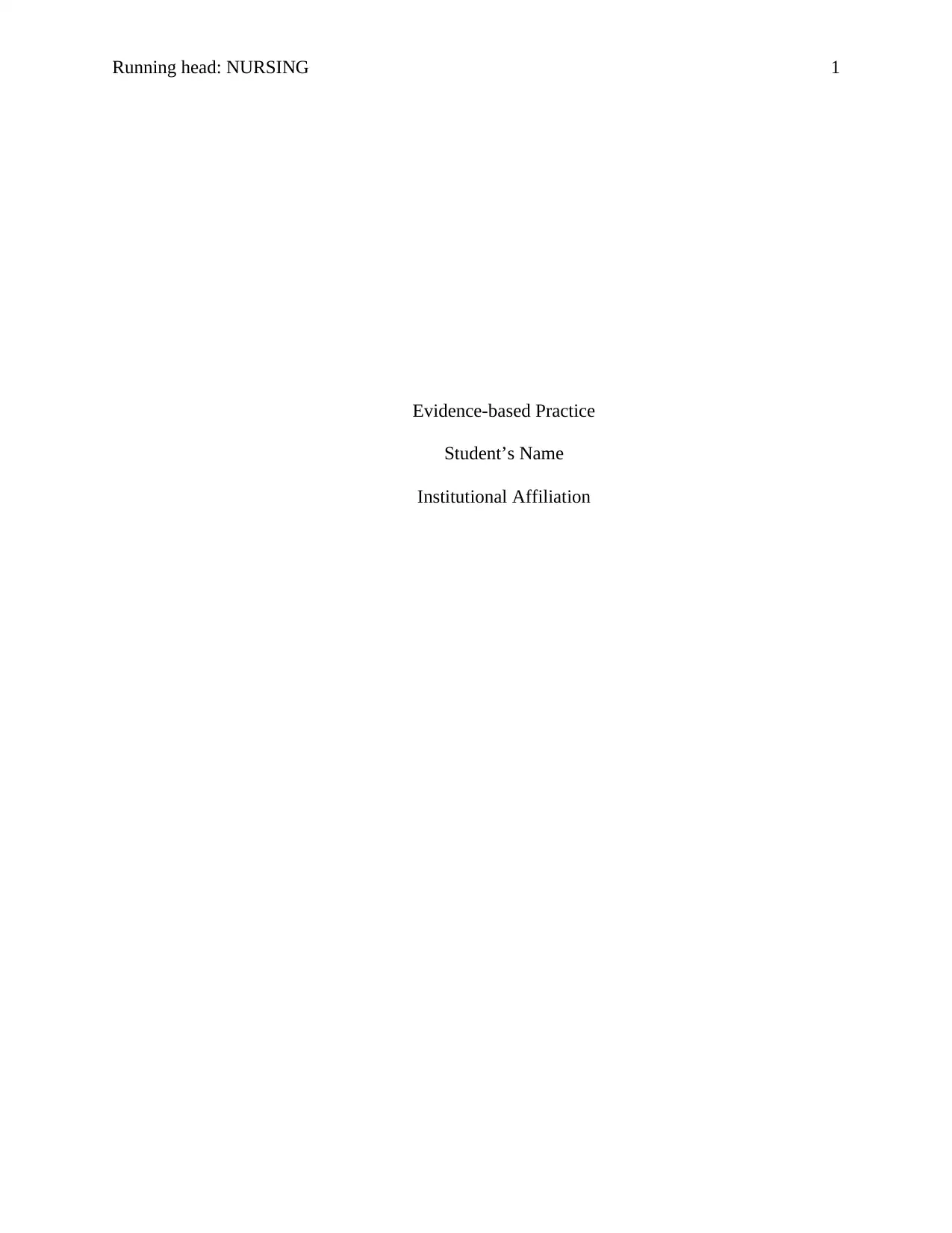
Running head: NURSING 1
Evidence-based Practice
Student’s Name
Institutional Affiliation
Evidence-based Practice
Student’s Name
Institutional Affiliation
Paraphrase This Document
Need a fresh take? Get an instant paraphrase of this document with our AI Paraphraser
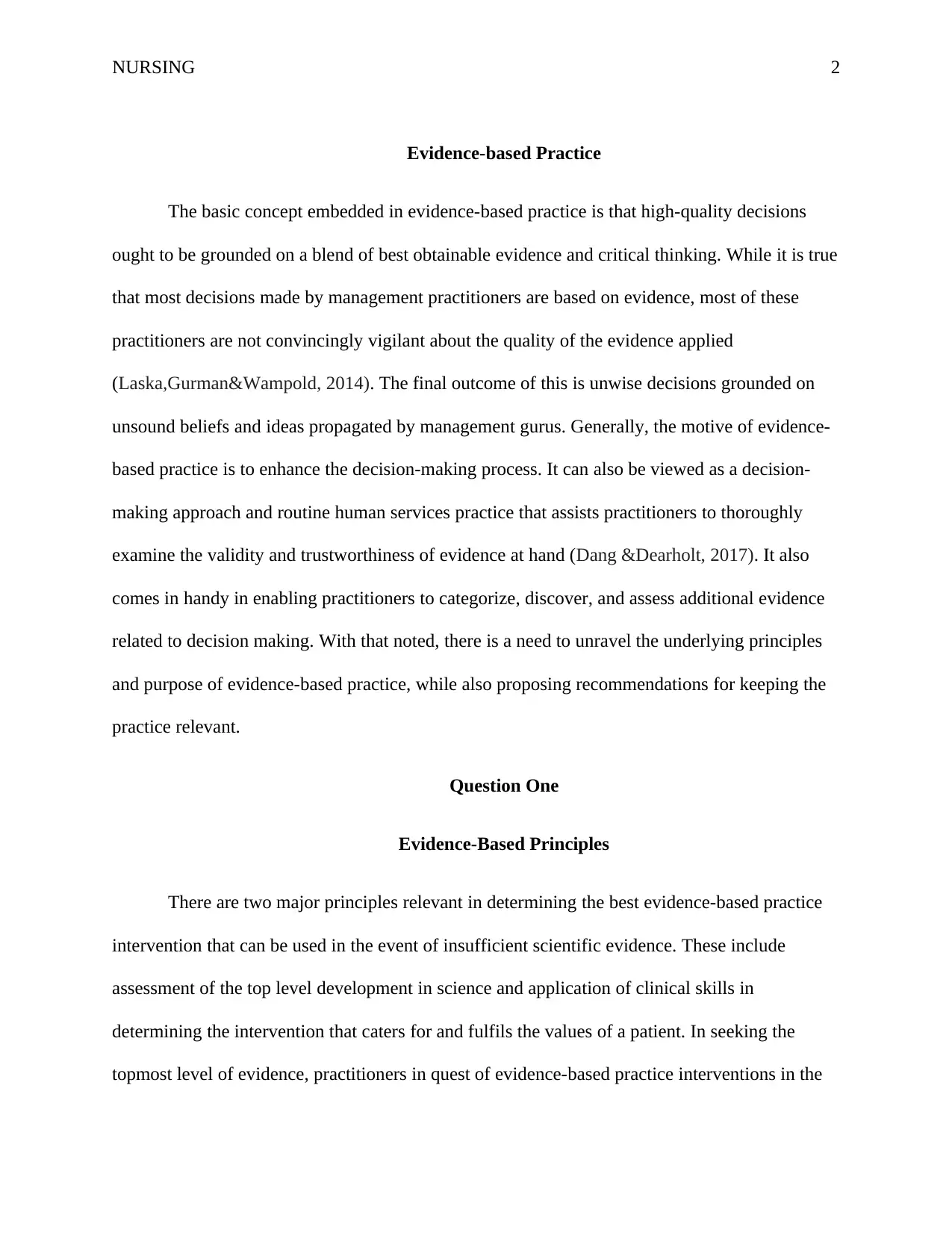
NURSING 2
Evidence-based Practice
The basic concept embedded in evidence-based practice is that high-quality decisions
ought to be grounded on a blend of best obtainable evidence and critical thinking. While it is true
that most decisions made by management practitioners are based on evidence, most of these
practitioners are not convincingly vigilant about the quality of the evidence applied
(Laska,Gurman&Wampold, 2014). The final outcome of this is unwise decisions grounded on
unsound beliefs and ideas propagated by management gurus. Generally, the motive of evidence-
based practice is to enhance the decision-making process. It can also be viewed as a decision-
making approach and routine human services practice that assists practitioners to thoroughly
examine the validity and trustworthiness of evidence at hand (Dang &Dearholt, 2017). It also
comes in handy in enabling practitioners to categorize, discover, and assess additional evidence
related to decision making. With that noted, there is a need to unravel the underlying principles
and purpose of evidence-based practice, while also proposing recommendations for keeping the
practice relevant.
Question One
Evidence-Based Principles
There are two major principles relevant in determining the best evidence-based practice
intervention that can be used in the event of insufficient scientific evidence. These include
assessment of the top level development in science and application of clinical skills in
determining the intervention that caters for and fulfils the values of a patient. In seeking the
topmost level of evidence, practitioners in quest of evidence-based practice interventions in the
Evidence-based Practice
The basic concept embedded in evidence-based practice is that high-quality decisions
ought to be grounded on a blend of best obtainable evidence and critical thinking. While it is true
that most decisions made by management practitioners are based on evidence, most of these
practitioners are not convincingly vigilant about the quality of the evidence applied
(Laska,Gurman&Wampold, 2014). The final outcome of this is unwise decisions grounded on
unsound beliefs and ideas propagated by management gurus. Generally, the motive of evidence-
based practice is to enhance the decision-making process. It can also be viewed as a decision-
making approach and routine human services practice that assists practitioners to thoroughly
examine the validity and trustworthiness of evidence at hand (Dang &Dearholt, 2017). It also
comes in handy in enabling practitioners to categorize, discover, and assess additional evidence
related to decision making. With that noted, there is a need to unravel the underlying principles
and purpose of evidence-based practice, while also proposing recommendations for keeping the
practice relevant.
Question One
Evidence-Based Principles
There are two major principles relevant in determining the best evidence-based practice
intervention that can be used in the event of insufficient scientific evidence. These include
assessment of the top level development in science and application of clinical skills in
determining the intervention that caters for and fulfils the values of a patient. In seeking the
topmost level of evidence, practitioners in quest of evidence-based practice interventions in the
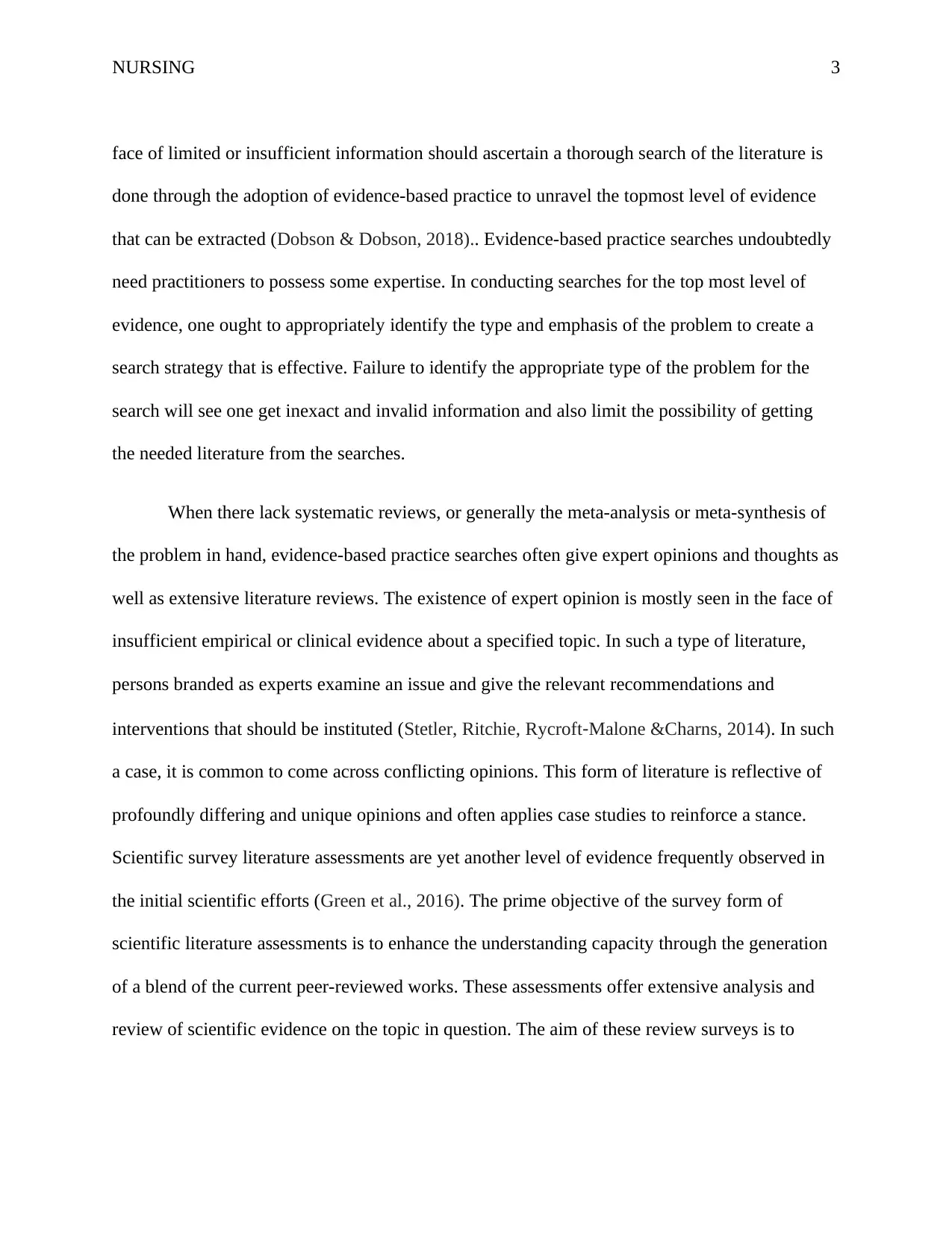
NURSING 3
face of limited or insufficient information should ascertain a thorough search of the literature is
done through the adoption of evidence-based practice to unravel the topmost level of evidence
that can be extracted (Dobson & Dobson, 2018).. Evidence-based practice searches undoubtedly
need practitioners to possess some expertise. In conducting searches for the top most level of
evidence, one ought to appropriately identify the type and emphasis of the problem to create a
search strategy that is effective. Failure to identify the appropriate type of the problem for the
search will see one get inexact and invalid information and also limit the possibility of getting
the needed literature from the searches.
When there lack systematic reviews, or generally the meta-analysis or meta-synthesis of
the problem in hand, evidence-based practice searches often give expert opinions and thoughts as
well as extensive literature reviews. The existence of expert opinion is mostly seen in the face of
insufficient empirical or clinical evidence about a specified topic. In such a type of literature,
persons branded as experts examine an issue and give the relevant recommendations and
interventions that should be instituted (Stetler, Ritchie, Rycroft‐Malone &Charns, 2014). In such
a case, it is common to come across conflicting opinions. This form of literature is reflective of
profoundly differing and unique opinions and often applies case studies to reinforce a stance.
Scientific survey literature assessments are yet another level of evidence frequently observed in
the initial scientific efforts (Green et al., 2016). The prime objective of the survey form of
scientific literature assessments is to enhance the understanding capacity through the generation
of a blend of the current peer-reviewed works. These assessments offer extensive analysis and
review of scientific evidence on the topic in question. The aim of these review surveys is to
face of limited or insufficient information should ascertain a thorough search of the literature is
done through the adoption of evidence-based practice to unravel the topmost level of evidence
that can be extracted (Dobson & Dobson, 2018).. Evidence-based practice searches undoubtedly
need practitioners to possess some expertise. In conducting searches for the top most level of
evidence, one ought to appropriately identify the type and emphasis of the problem to create a
search strategy that is effective. Failure to identify the appropriate type of the problem for the
search will see one get inexact and invalid information and also limit the possibility of getting
the needed literature from the searches.
When there lack systematic reviews, or generally the meta-analysis or meta-synthesis of
the problem in hand, evidence-based practice searches often give expert opinions and thoughts as
well as extensive literature reviews. The existence of expert opinion is mostly seen in the face of
insufficient empirical or clinical evidence about a specified topic. In such a type of literature,
persons branded as experts examine an issue and give the relevant recommendations and
interventions that should be instituted (Stetler, Ritchie, Rycroft‐Malone &Charns, 2014). In such
a case, it is common to come across conflicting opinions. This form of literature is reflective of
profoundly differing and unique opinions and often applies case studies to reinforce a stance.
Scientific survey literature assessments are yet another level of evidence frequently observed in
the initial scientific efforts (Green et al., 2016). The prime objective of the survey form of
scientific literature assessments is to enhance the understanding capacity through the generation
of a blend of the current peer-reviewed works. These assessments offer extensive analysis and
review of scientific evidence on the topic in question. The aim of these review surveys is to
⊘ This is a preview!⊘
Do you want full access?
Subscribe today to unlock all pages.

Trusted by 1+ million students worldwide
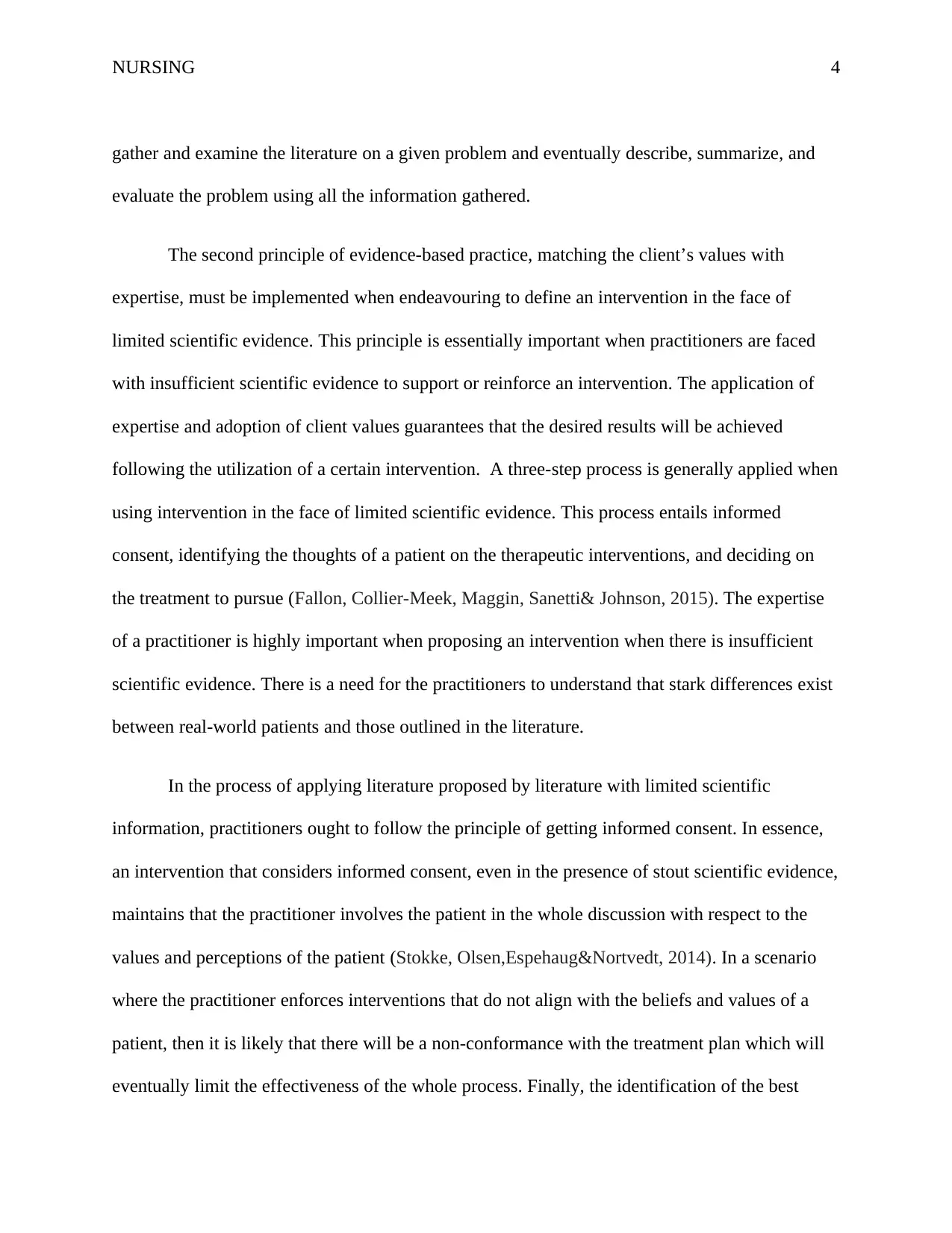
NURSING 4
gather and examine the literature on a given problem and eventually describe, summarize, and
evaluate the problem using all the information gathered.
The second principle of evidence-based practice, matching the client’s values with
expertise, must be implemented when endeavouring to define an intervention in the face of
limited scientific evidence. This principle is essentially important when practitioners are faced
with insufficient scientific evidence to support or reinforce an intervention. The application of
expertise and adoption of client values guarantees that the desired results will be achieved
following the utilization of a certain intervention. A three-step process is generally applied when
using intervention in the face of limited scientific evidence. This process entails informed
consent, identifying the thoughts of a patient on the therapeutic interventions, and deciding on
the treatment to pursue (Fallon, Collier-Meek, Maggin, Sanetti& Johnson, 2015). The expertise
of a practitioner is highly important when proposing an intervention when there is insufficient
scientific evidence. There is a need for the practitioners to understand that stark differences exist
between real-world patients and those outlined in the literature.
In the process of applying literature proposed by literature with limited scientific
information, practitioners ought to follow the principle of getting informed consent. In essence,
an intervention that considers informed consent, even in the presence of stout scientific evidence,
maintains that the practitioner involves the patient in the whole discussion with respect to the
values and perceptions of the patient (Stokke, Olsen,Espehaug&Nortvedt, 2014). In a scenario
where the practitioner enforces interventions that do not align with the beliefs and values of a
patient, then it is likely that there will be a non-conformance with the treatment plan which will
eventually limit the effectiveness of the whole process. Finally, the identification of the best
gather and examine the literature on a given problem and eventually describe, summarize, and
evaluate the problem using all the information gathered.
The second principle of evidence-based practice, matching the client’s values with
expertise, must be implemented when endeavouring to define an intervention in the face of
limited scientific evidence. This principle is essentially important when practitioners are faced
with insufficient scientific evidence to support or reinforce an intervention. The application of
expertise and adoption of client values guarantees that the desired results will be achieved
following the utilization of a certain intervention. A three-step process is generally applied when
using intervention in the face of limited scientific evidence. This process entails informed
consent, identifying the thoughts of a patient on the therapeutic interventions, and deciding on
the treatment to pursue (Fallon, Collier-Meek, Maggin, Sanetti& Johnson, 2015). The expertise
of a practitioner is highly important when proposing an intervention when there is insufficient
scientific evidence. There is a need for the practitioners to understand that stark differences exist
between real-world patients and those outlined in the literature.
In the process of applying literature proposed by literature with limited scientific
information, practitioners ought to follow the principle of getting informed consent. In essence,
an intervention that considers informed consent, even in the presence of stout scientific evidence,
maintains that the practitioner involves the patient in the whole discussion with respect to the
values and perceptions of the patient (Stokke, Olsen,Espehaug&Nortvedt, 2014). In a scenario
where the practitioner enforces interventions that do not align with the beliefs and values of a
patient, then it is likely that there will be a non-conformance with the treatment plan which will
eventually limit the effectiveness of the whole process. Finally, the identification of the best
Paraphrase This Document
Need a fresh take? Get an instant paraphrase of this document with our AI Paraphraser
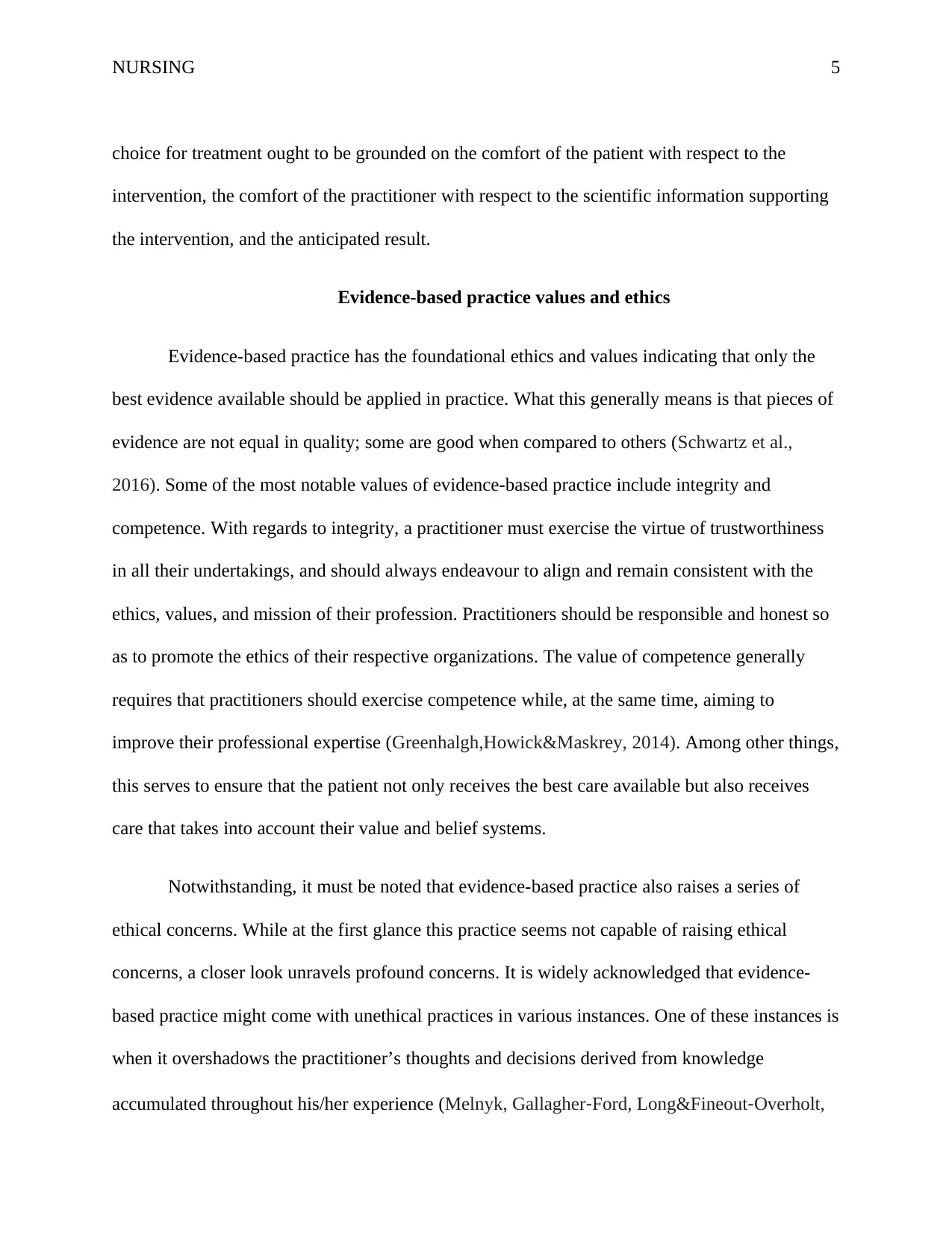
NURSING 5
choice for treatment ought to be grounded on the comfort of the patient with respect to the
intervention, the comfort of the practitioner with respect to the scientific information supporting
the intervention, and the anticipated result.
Evidence-based practice values and ethics
Evidence-based practice has the foundational ethics and values indicating that only the
best evidence available should be applied in practice. What this generally means is that pieces of
evidence are not equal in quality; some are good when compared to others (Schwartz et al.,
2016). Some of the most notable values of evidence-based practice include integrity and
competence. With regards to integrity, a practitioner must exercise the virtue of trustworthiness
in all their undertakings, and should always endeavour to align and remain consistent with the
ethics, values, and mission of their profession. Practitioners should be responsible and honest so
as to promote the ethics of their respective organizations. The value of competence generally
requires that practitioners should exercise competence while, at the same time, aiming to
improve their professional expertise (Greenhalgh,Howick&Maskrey, 2014). Among other things,
this serves to ensure that the patient not only receives the best care available but also receives
care that takes into account their value and belief systems.
Notwithstanding, it must be noted that evidence-based practice also raises a series of
ethical concerns. While at the first glance this practice seems not capable of raising ethical
concerns, a closer look unravels profound concerns. It is widely acknowledged that evidence-
based practice might come with unethical practices in various instances. One of these instances is
when it overshadows the practitioner’s thoughts and decisions derived from knowledge
accumulated throughout his/her experience (Melnyk, Gallagher‐Ford, Long&Fineout‐Overholt,
choice for treatment ought to be grounded on the comfort of the patient with respect to the
intervention, the comfort of the practitioner with respect to the scientific information supporting
the intervention, and the anticipated result.
Evidence-based practice values and ethics
Evidence-based practice has the foundational ethics and values indicating that only the
best evidence available should be applied in practice. What this generally means is that pieces of
evidence are not equal in quality; some are good when compared to others (Schwartz et al.,
2016). Some of the most notable values of evidence-based practice include integrity and
competence. With regards to integrity, a practitioner must exercise the virtue of trustworthiness
in all their undertakings, and should always endeavour to align and remain consistent with the
ethics, values, and mission of their profession. Practitioners should be responsible and honest so
as to promote the ethics of their respective organizations. The value of competence generally
requires that practitioners should exercise competence while, at the same time, aiming to
improve their professional expertise (Greenhalgh,Howick&Maskrey, 2014). Among other things,
this serves to ensure that the patient not only receives the best care available but also receives
care that takes into account their value and belief systems.
Notwithstanding, it must be noted that evidence-based practice also raises a series of
ethical concerns. While at the first glance this practice seems not capable of raising ethical
concerns, a closer look unravels profound concerns. It is widely acknowledged that evidence-
based practice might come with unethical practices in various instances. One of these instances is
when it overshadows the practitioner’s thoughts and decisions derived from knowledge
accumulated throughout his/her experience (Melnyk, Gallagher‐Ford, Long&Fineout‐Overholt,
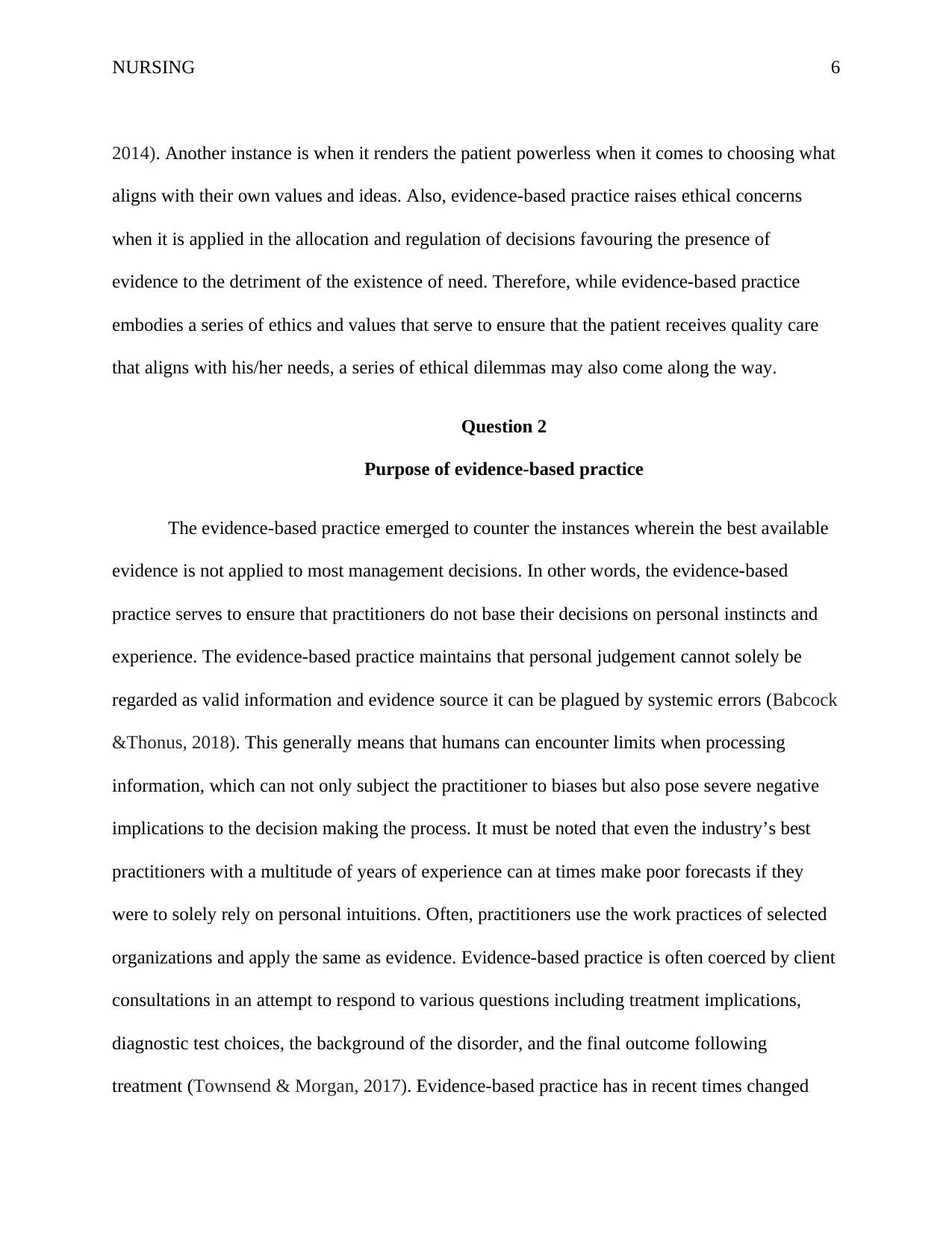
NURSING 6
2014). Another instance is when it renders the patient powerless when it comes to choosing what
aligns with their own values and ideas. Also, evidence-based practice raises ethical concerns
when it is applied in the allocation and regulation of decisions favouring the presence of
evidence to the detriment of the existence of need. Therefore, while evidence-based practice
embodies a series of ethics and values that serve to ensure that the patient receives quality care
that aligns with his/her needs, a series of ethical dilemmas may also come along the way.
Question 2
Purpose of evidence-based practice
The evidence-based practice emerged to counter the instances wherein the best available
evidence is not applied to most management decisions. In other words, the evidence-based
practice serves to ensure that practitioners do not base their decisions on personal instincts and
experience. The evidence-based practice maintains that personal judgement cannot solely be
regarded as valid information and evidence source it can be plagued by systemic errors (Babcock
&Thonus, 2018). This generally means that humans can encounter limits when processing
information, which can not only subject the practitioner to biases but also pose severe negative
implications to the decision making the process. It must be noted that even the industry’s best
practitioners with a multitude of years of experience can at times make poor forecasts if they
were to solely rely on personal intuitions. Often, practitioners use the work practices of selected
organizations and apply the same as evidence. Evidence-based practice is often coerced by client
consultations in an attempt to respond to various questions including treatment implications,
diagnostic test choices, the background of the disorder, and the final outcome following
treatment (Townsend & Morgan, 2017). Evidence-based practice has in recent times changed
2014). Another instance is when it renders the patient powerless when it comes to choosing what
aligns with their own values and ideas. Also, evidence-based practice raises ethical concerns
when it is applied in the allocation and regulation of decisions favouring the presence of
evidence to the detriment of the existence of need. Therefore, while evidence-based practice
embodies a series of ethics and values that serve to ensure that the patient receives quality care
that aligns with his/her needs, a series of ethical dilemmas may also come along the way.
Question 2
Purpose of evidence-based practice
The evidence-based practice emerged to counter the instances wherein the best available
evidence is not applied to most management decisions. In other words, the evidence-based
practice serves to ensure that practitioners do not base their decisions on personal instincts and
experience. The evidence-based practice maintains that personal judgement cannot solely be
regarded as valid information and evidence source it can be plagued by systemic errors (Babcock
&Thonus, 2018). This generally means that humans can encounter limits when processing
information, which can not only subject the practitioner to biases but also pose severe negative
implications to the decision making the process. It must be noted that even the industry’s best
practitioners with a multitude of years of experience can at times make poor forecasts if they
were to solely rely on personal intuitions. Often, practitioners use the work practices of selected
organizations and apply the same as evidence. Evidence-based practice is often coerced by client
consultations in an attempt to respond to various questions including treatment implications,
diagnostic test choices, the background of the disorder, and the final outcome following
treatment (Townsend & Morgan, 2017). Evidence-based practice has in recent times changed
⊘ This is a preview!⊘
Do you want full access?
Subscribe today to unlock all pages.

Trusted by 1+ million students worldwide
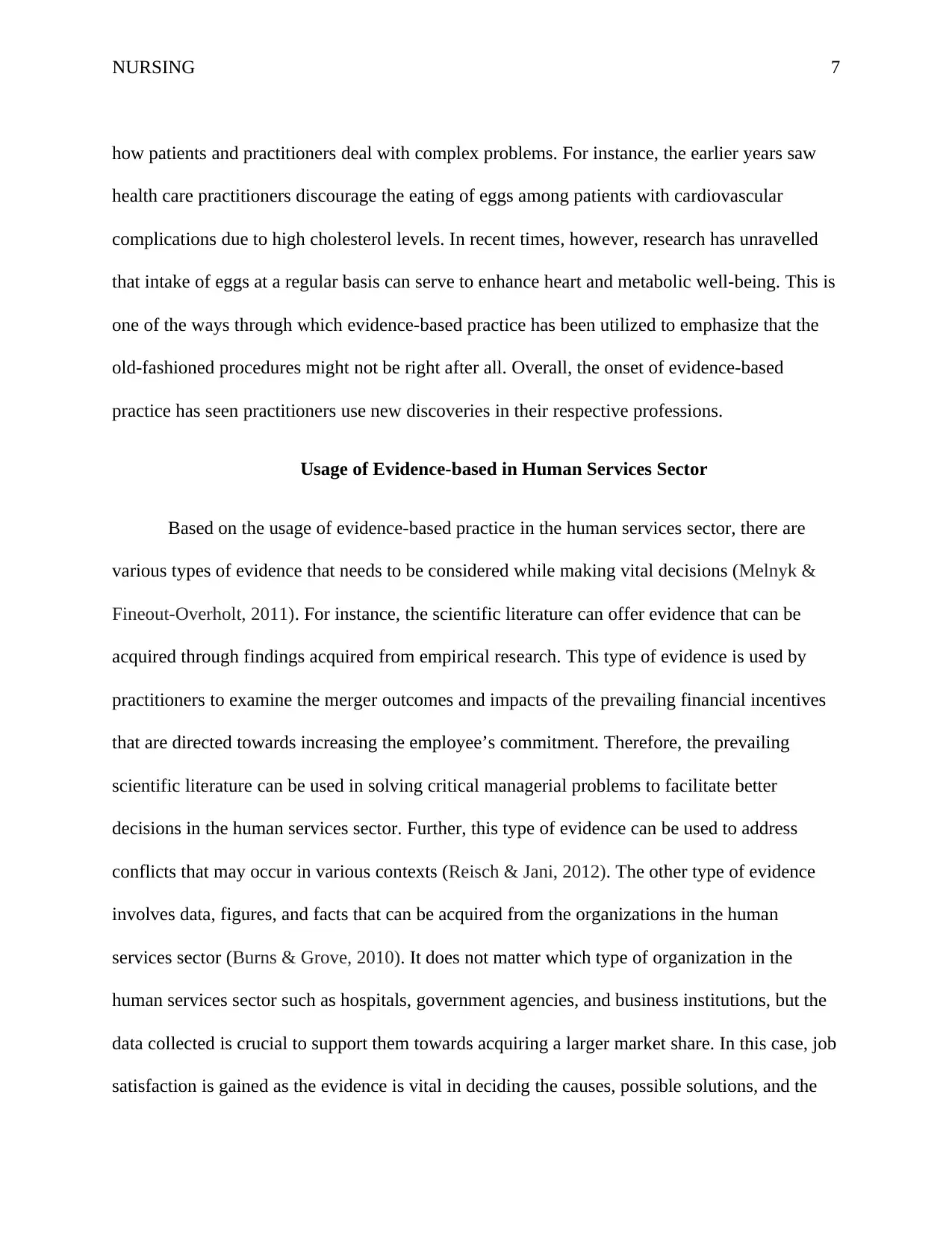
NURSING 7
how patients and practitioners deal with complex problems. For instance, the earlier years saw
health care practitioners discourage the eating of eggs among patients with cardiovascular
complications due to high cholesterol levels. In recent times, however, research has unravelled
that intake of eggs at a regular basis can serve to enhance heart and metabolic well-being. This is
one of the ways through which evidence-based practice has been utilized to emphasize that the
old-fashioned procedures might not be right after all. Overall, the onset of evidence-based
practice has seen practitioners use new discoveries in their respective professions.
Usage of Evidence-based in Human Services Sector
Based on the usage of evidence-based practice in the human services sector, there are
various types of evidence that needs to be considered while making vital decisions (Melnyk &
Fineout-Overholt, 2011). For instance, the scientific literature can offer evidence that can be
acquired through findings acquired from empirical research. This type of evidence is used by
practitioners to examine the merger outcomes and impacts of the prevailing financial incentives
that are directed towards increasing the employee’s commitment. Therefore, the prevailing
scientific literature can be used in solving critical managerial problems to facilitate better
decisions in the human services sector. Further, this type of evidence can be used to address
conflicts that may occur in various contexts (Reisch & Jani, 2012). The other type of evidence
involves data, figures, and facts that can be acquired from the organizations in the human
services sector (Burns & Grove, 2010). It does not matter which type of organization in the
human services sector such as hospitals, government agencies, and business institutions, but the
data collected is crucial to support them towards acquiring a larger market share. In this case, job
satisfaction is gained as the evidence is vital in deciding the causes, possible solutions, and the
how patients and practitioners deal with complex problems. For instance, the earlier years saw
health care practitioners discourage the eating of eggs among patients with cardiovascular
complications due to high cholesterol levels. In recent times, however, research has unravelled
that intake of eggs at a regular basis can serve to enhance heart and metabolic well-being. This is
one of the ways through which evidence-based practice has been utilized to emphasize that the
old-fashioned procedures might not be right after all. Overall, the onset of evidence-based
practice has seen practitioners use new discoveries in their respective professions.
Usage of Evidence-based in Human Services Sector
Based on the usage of evidence-based practice in the human services sector, there are
various types of evidence that needs to be considered while making vital decisions (Melnyk &
Fineout-Overholt, 2011). For instance, the scientific literature can offer evidence that can be
acquired through findings acquired from empirical research. This type of evidence is used by
practitioners to examine the merger outcomes and impacts of the prevailing financial incentives
that are directed towards increasing the employee’s commitment. Therefore, the prevailing
scientific literature can be used in solving critical managerial problems to facilitate better
decisions in the human services sector. Further, this type of evidence can be used to address
conflicts that may occur in various contexts (Reisch & Jani, 2012). The other type of evidence
involves data, figures, and facts that can be acquired from the organizations in the human
services sector (Burns & Grove, 2010). It does not matter which type of organization in the
human services sector such as hospitals, government agencies, and business institutions, but the
data collected is crucial to support them towards acquiring a larger market share. In this case, job
satisfaction is gained as the evidence is vital in deciding the causes, possible solutions, and the
Paraphrase This Document
Need a fresh take? Get an instant paraphrase of this document with our AI Paraphraser
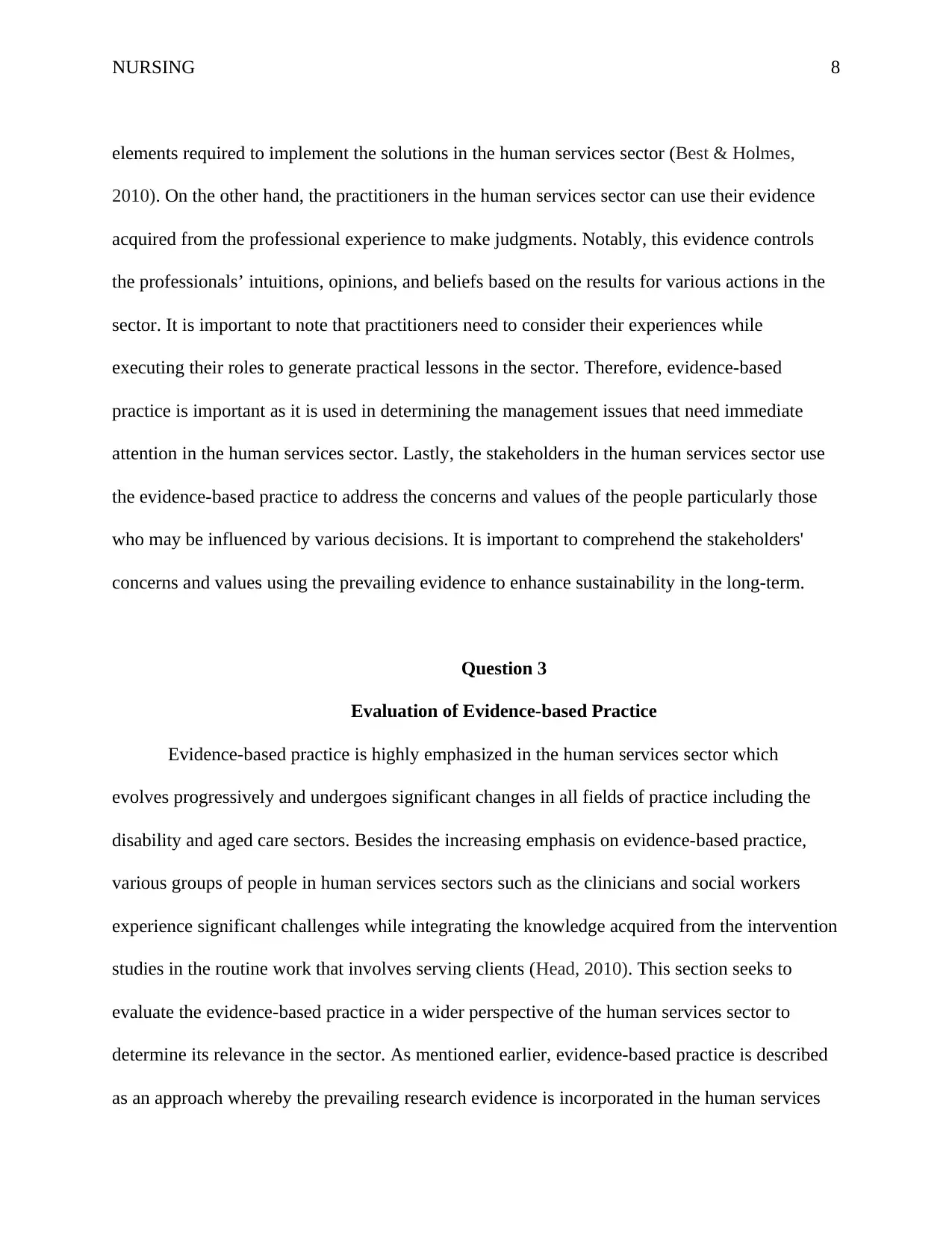
NURSING 8
elements required to implement the solutions in the human services sector (Best & Holmes,
2010). On the other hand, the practitioners in the human services sector can use their evidence
acquired from the professional experience to make judgments. Notably, this evidence controls
the professionals’ intuitions, opinions, and beliefs based on the results for various actions in the
sector. It is important to note that practitioners need to consider their experiences while
executing their roles to generate practical lessons in the sector. Therefore, evidence-based
practice is important as it is used in determining the management issues that need immediate
attention in the human services sector. Lastly, the stakeholders in the human services sector use
the evidence-based practice to address the concerns and values of the people particularly those
who may be influenced by various decisions. It is important to comprehend the stakeholders'
concerns and values using the prevailing evidence to enhance sustainability in the long-term.
Question 3
Evaluation of Evidence-based Practice
Evidence-based practice is highly emphasized in the human services sector which
evolves progressively and undergoes significant changes in all fields of practice including the
disability and aged care sectors. Besides the increasing emphasis on evidence-based practice,
various groups of people in human services sectors such as the clinicians and social workers
experience significant challenges while integrating the knowledge acquired from the intervention
studies in the routine work that involves serving clients (Head, 2010). This section seeks to
evaluate the evidence-based practice in a wider perspective of the human services sector to
determine its relevance in the sector. As mentioned earlier, evidence-based practice is described
as an approach whereby the prevailing research evidence is incorporated in the human services
elements required to implement the solutions in the human services sector (Best & Holmes,
2010). On the other hand, the practitioners in the human services sector can use their evidence
acquired from the professional experience to make judgments. Notably, this evidence controls
the professionals’ intuitions, opinions, and beliefs based on the results for various actions in the
sector. It is important to note that practitioners need to consider their experiences while
executing their roles to generate practical lessons in the sector. Therefore, evidence-based
practice is important as it is used in determining the management issues that need immediate
attention in the human services sector. Lastly, the stakeholders in the human services sector use
the evidence-based practice to address the concerns and values of the people particularly those
who may be influenced by various decisions. It is important to comprehend the stakeholders'
concerns and values using the prevailing evidence to enhance sustainability in the long-term.
Question 3
Evaluation of Evidence-based Practice
Evidence-based practice is highly emphasized in the human services sector which
evolves progressively and undergoes significant changes in all fields of practice including the
disability and aged care sectors. Besides the increasing emphasis on evidence-based practice,
various groups of people in human services sectors such as the clinicians and social workers
experience significant challenges while integrating the knowledge acquired from the intervention
studies in the routine work that involves serving clients (Head, 2010). This section seeks to
evaluate the evidence-based practice in a wider perspective of the human services sector to
determine its relevance in the sector. As mentioned earlier, evidence-based practice is described
as an approach whereby the prevailing research evidence is incorporated in the human services
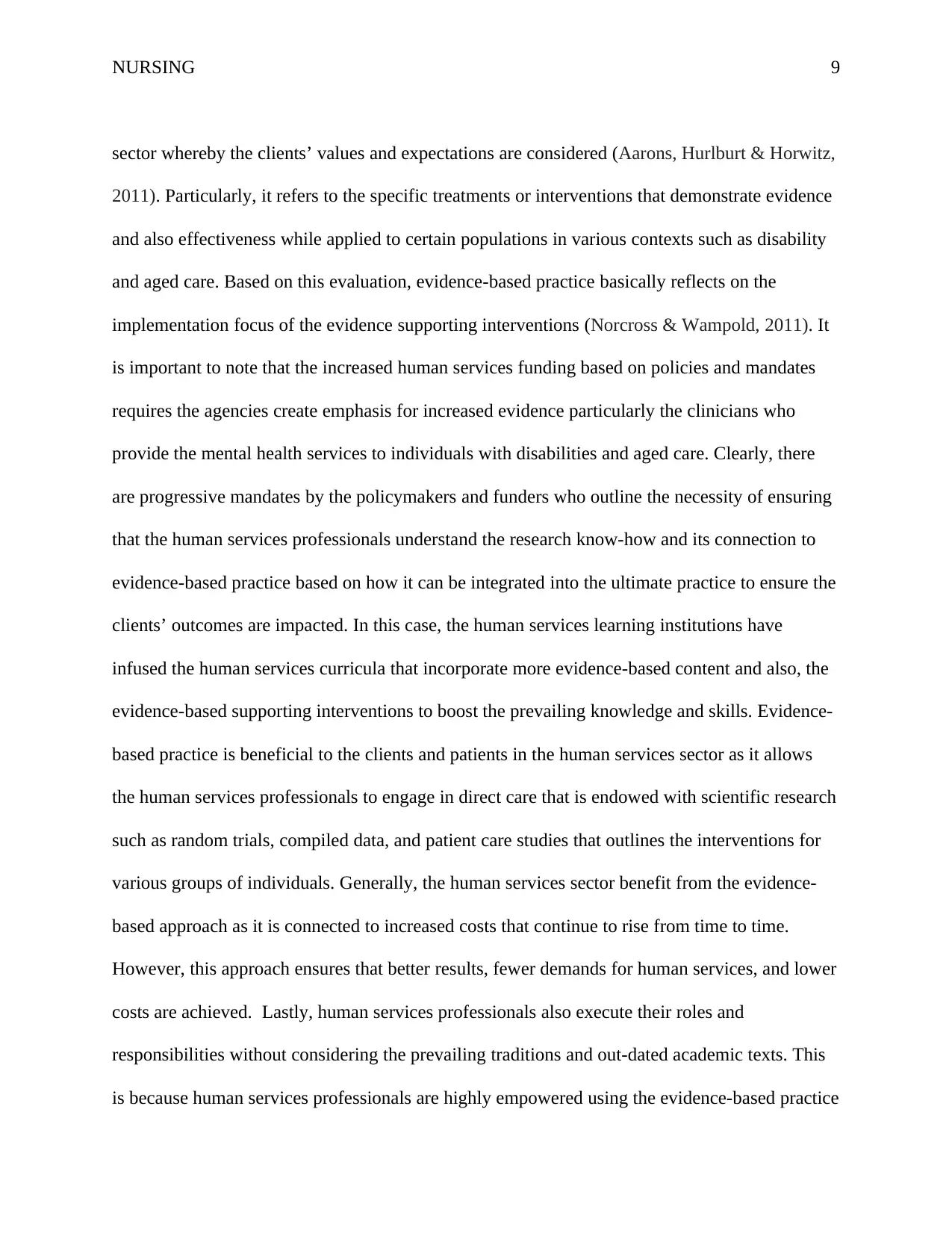
NURSING 9
sector whereby the clients’ values and expectations are considered (Aarons, Hurlburt & Horwitz,
2011). Particularly, it refers to the specific treatments or interventions that demonstrate evidence
and also effectiveness while applied to certain populations in various contexts such as disability
and aged care. Based on this evaluation, evidence-based practice basically reflects on the
implementation focus of the evidence supporting interventions (Norcross & Wampold, 2011). It
is important to note that the increased human services funding based on policies and mandates
requires the agencies create emphasis for increased evidence particularly the clinicians who
provide the mental health services to individuals with disabilities and aged care. Clearly, there
are progressive mandates by the policymakers and funders who outline the necessity of ensuring
that the human services professionals understand the research know-how and its connection to
evidence-based practice based on how it can be integrated into the ultimate practice to ensure the
clients’ outcomes are impacted. In this case, the human services learning institutions have
infused the human services curricula that incorporate more evidence-based content and also, the
evidence-based supporting interventions to boost the prevailing knowledge and skills. Evidence-
based practice is beneficial to the clients and patients in the human services sector as it allows
the human services professionals to engage in direct care that is endowed with scientific research
such as random trials, compiled data, and patient care studies that outlines the interventions for
various groups of individuals. Generally, the human services sector benefit from the evidence-
based approach as it is connected to increased costs that continue to rise from time to time.
However, this approach ensures that better results, fewer demands for human services, and lower
costs are achieved. Lastly, human services professionals also execute their roles and
responsibilities without considering the prevailing traditions and out-dated academic texts. This
is because human services professionals are highly empowered using the evidence-based practice
sector whereby the clients’ values and expectations are considered (Aarons, Hurlburt & Horwitz,
2011). Particularly, it refers to the specific treatments or interventions that demonstrate evidence
and also effectiveness while applied to certain populations in various contexts such as disability
and aged care. Based on this evaluation, evidence-based practice basically reflects on the
implementation focus of the evidence supporting interventions (Norcross & Wampold, 2011). It
is important to note that the increased human services funding based on policies and mandates
requires the agencies create emphasis for increased evidence particularly the clinicians who
provide the mental health services to individuals with disabilities and aged care. Clearly, there
are progressive mandates by the policymakers and funders who outline the necessity of ensuring
that the human services professionals understand the research know-how and its connection to
evidence-based practice based on how it can be integrated into the ultimate practice to ensure the
clients’ outcomes are impacted. In this case, the human services learning institutions have
infused the human services curricula that incorporate more evidence-based content and also, the
evidence-based supporting interventions to boost the prevailing knowledge and skills. Evidence-
based practice is beneficial to the clients and patients in the human services sector as it allows
the human services professionals to engage in direct care that is endowed with scientific research
such as random trials, compiled data, and patient care studies that outlines the interventions for
various groups of individuals. Generally, the human services sector benefit from the evidence-
based approach as it is connected to increased costs that continue to rise from time to time.
However, this approach ensures that better results, fewer demands for human services, and lower
costs are achieved. Lastly, human services professionals also execute their roles and
responsibilities without considering the prevailing traditions and out-dated academic texts. This
is because human services professionals are highly empowered using the evidence-based practice
⊘ This is a preview!⊘
Do you want full access?
Subscribe today to unlock all pages.

Trusted by 1+ million students worldwide
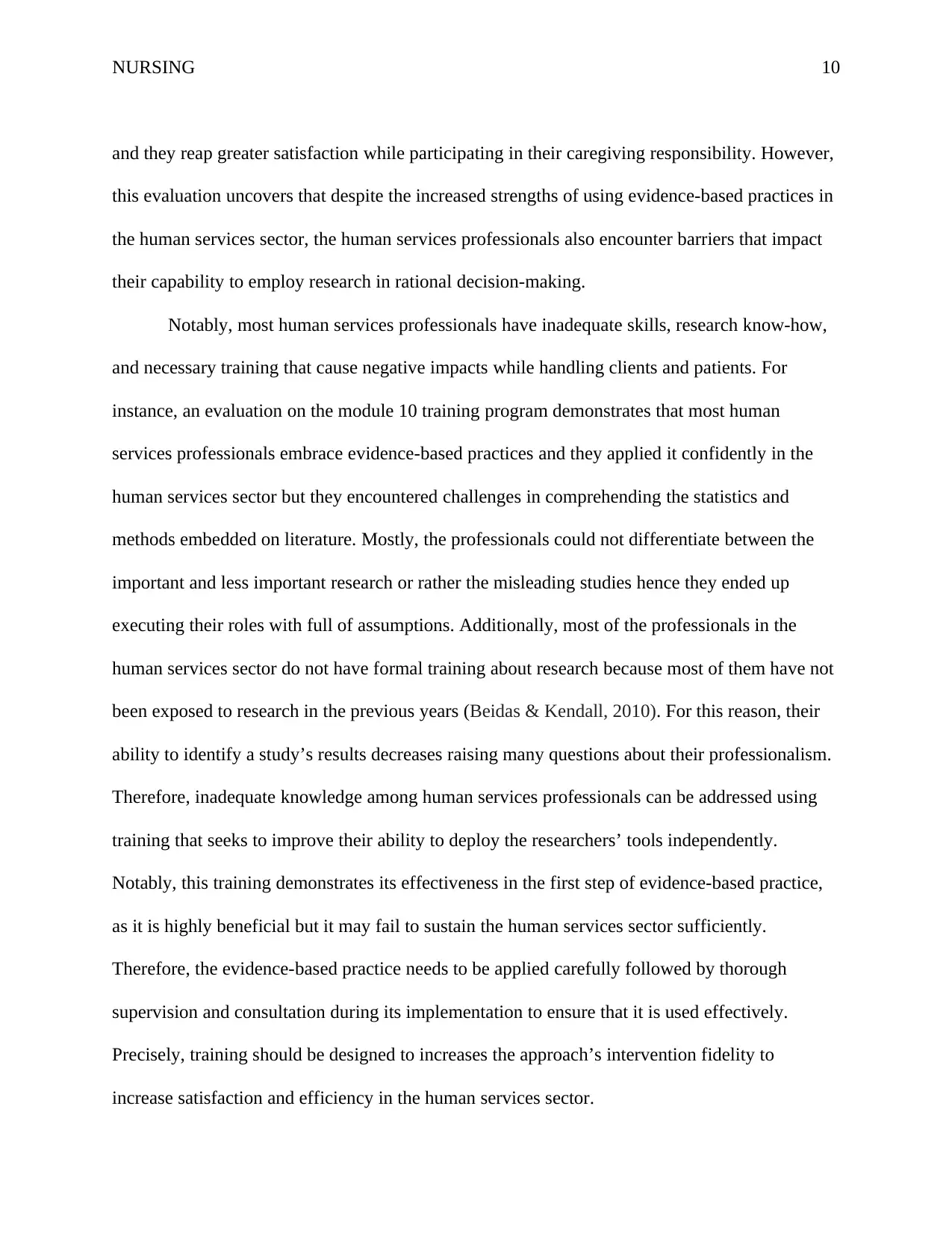
NURSING 10
and they reap greater satisfaction while participating in their caregiving responsibility. However,
this evaluation uncovers that despite the increased strengths of using evidence-based practices in
the human services sector, the human services professionals also encounter barriers that impact
their capability to employ research in rational decision-making.
Notably, most human services professionals have inadequate skills, research know-how,
and necessary training that cause negative impacts while handling clients and patients. For
instance, an evaluation on the module 10 training program demonstrates that most human
services professionals embrace evidence-based practices and they applied it confidently in the
human services sector but they encountered challenges in comprehending the statistics and
methods embedded on literature. Mostly, the professionals could not differentiate between the
important and less important research or rather the misleading studies hence they ended up
executing their roles with full of assumptions. Additionally, most of the professionals in the
human services sector do not have formal training about research because most of them have not
been exposed to research in the previous years (Beidas & Kendall, 2010). For this reason, their
ability to identify a study’s results decreases raising many questions about their professionalism.
Therefore, inadequate knowledge among human services professionals can be addressed using
training that seeks to improve their ability to deploy the researchers’ tools independently.
Notably, this training demonstrates its effectiveness in the first step of evidence-based practice,
as it is highly beneficial but it may fail to sustain the human services sector sufficiently.
Therefore, the evidence-based practice needs to be applied carefully followed by thorough
supervision and consultation during its implementation to ensure that it is used effectively.
Precisely, training should be designed to increases the approach’s intervention fidelity to
increase satisfaction and efficiency in the human services sector.
and they reap greater satisfaction while participating in their caregiving responsibility. However,
this evaluation uncovers that despite the increased strengths of using evidence-based practices in
the human services sector, the human services professionals also encounter barriers that impact
their capability to employ research in rational decision-making.
Notably, most human services professionals have inadequate skills, research know-how,
and necessary training that cause negative impacts while handling clients and patients. For
instance, an evaluation on the module 10 training program demonstrates that most human
services professionals embrace evidence-based practices and they applied it confidently in the
human services sector but they encountered challenges in comprehending the statistics and
methods embedded on literature. Mostly, the professionals could not differentiate between the
important and less important research or rather the misleading studies hence they ended up
executing their roles with full of assumptions. Additionally, most of the professionals in the
human services sector do not have formal training about research because most of them have not
been exposed to research in the previous years (Beidas & Kendall, 2010). For this reason, their
ability to identify a study’s results decreases raising many questions about their professionalism.
Therefore, inadequate knowledge among human services professionals can be addressed using
training that seeks to improve their ability to deploy the researchers’ tools independently.
Notably, this training demonstrates its effectiveness in the first step of evidence-based practice,
as it is highly beneficial but it may fail to sustain the human services sector sufficiently.
Therefore, the evidence-based practice needs to be applied carefully followed by thorough
supervision and consultation during its implementation to ensure that it is used effectively.
Precisely, training should be designed to increases the approach’s intervention fidelity to
increase satisfaction and efficiency in the human services sector.
Paraphrase This Document
Need a fresh take? Get an instant paraphrase of this document with our AI Paraphraser
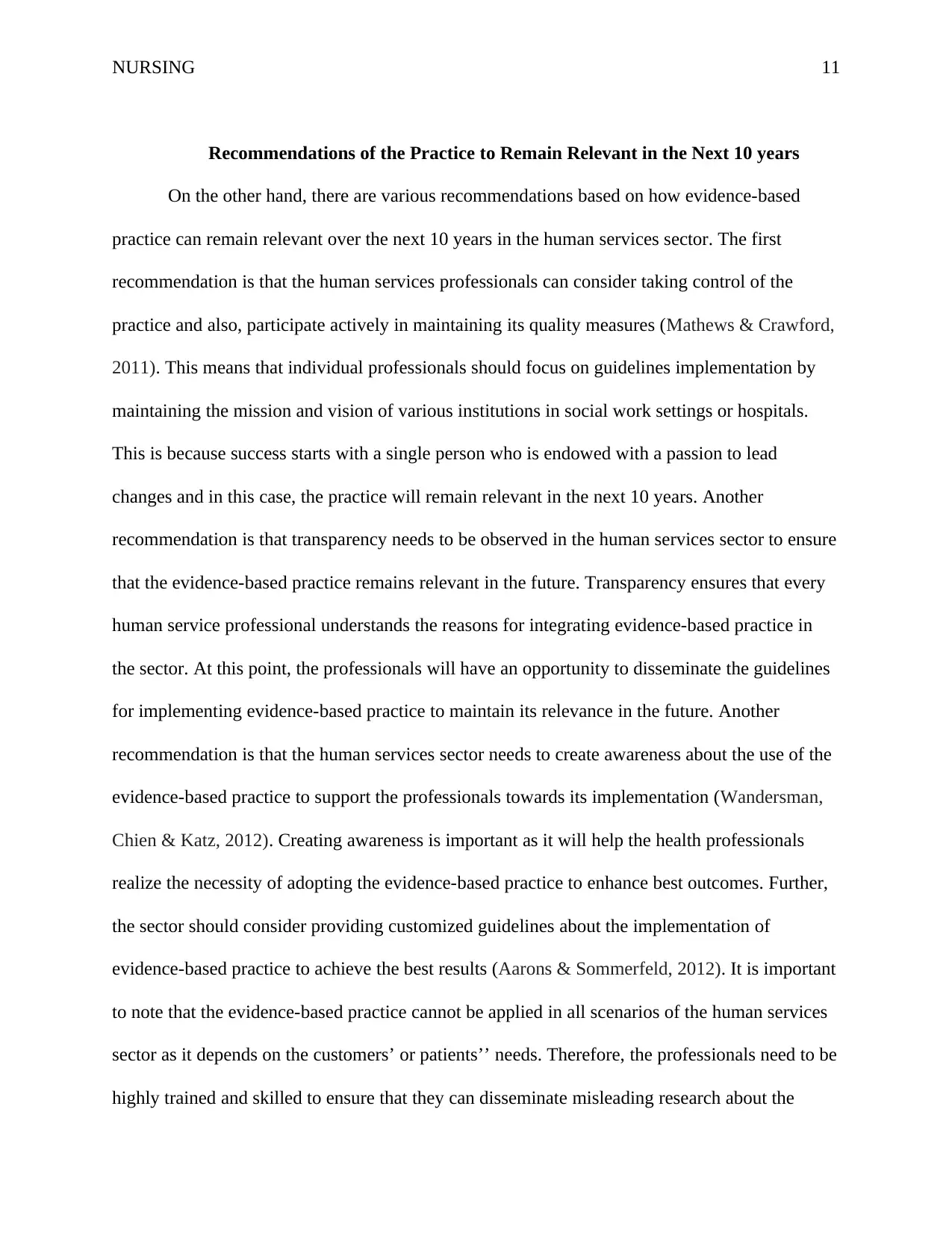
NURSING 11
Recommendations of the Practice to Remain Relevant in the Next 10 years
On the other hand, there are various recommendations based on how evidence-based
practice can remain relevant over the next 10 years in the human services sector. The first
recommendation is that the human services professionals can consider taking control of the
practice and also, participate actively in maintaining its quality measures (Mathews & Crawford,
2011). This means that individual professionals should focus on guidelines implementation by
maintaining the mission and vision of various institutions in social work settings or hospitals.
This is because success starts with a single person who is endowed with a passion to lead
changes and in this case, the practice will remain relevant in the next 10 years. Another
recommendation is that transparency needs to be observed in the human services sector to ensure
that the evidence-based practice remains relevant in the future. Transparency ensures that every
human service professional understands the reasons for integrating evidence-based practice in
the sector. At this point, the professionals will have an opportunity to disseminate the guidelines
for implementing evidence-based practice to maintain its relevance in the future. Another
recommendation is that the human services sector needs to create awareness about the use of the
evidence-based practice to support the professionals towards its implementation (Wandersman,
Chien & Katz, 2012). Creating awareness is important as it will help the health professionals
realize the necessity of adopting the evidence-based practice to enhance best outcomes. Further,
the sector should consider providing customized guidelines about the implementation of
evidence-based practice to achieve the best results (Aarons & Sommerfeld, 2012). It is important
to note that the evidence-based practice cannot be applied in all scenarios of the human services
sector as it depends on the customers’ or patients’’ needs. Therefore, the professionals need to be
highly trained and skilled to ensure that they can disseminate misleading research about the
Recommendations of the Practice to Remain Relevant in the Next 10 years
On the other hand, there are various recommendations based on how evidence-based
practice can remain relevant over the next 10 years in the human services sector. The first
recommendation is that the human services professionals can consider taking control of the
practice and also, participate actively in maintaining its quality measures (Mathews & Crawford,
2011). This means that individual professionals should focus on guidelines implementation by
maintaining the mission and vision of various institutions in social work settings or hospitals.
This is because success starts with a single person who is endowed with a passion to lead
changes and in this case, the practice will remain relevant in the next 10 years. Another
recommendation is that transparency needs to be observed in the human services sector to ensure
that the evidence-based practice remains relevant in the future. Transparency ensures that every
human service professional understands the reasons for integrating evidence-based practice in
the sector. At this point, the professionals will have an opportunity to disseminate the guidelines
for implementing evidence-based practice to maintain its relevance in the future. Another
recommendation is that the human services sector needs to create awareness about the use of the
evidence-based practice to support the professionals towards its implementation (Wandersman,
Chien & Katz, 2012). Creating awareness is important as it will help the health professionals
realize the necessity of adopting the evidence-based practice to enhance best outcomes. Further,
the sector should consider providing customized guidelines about the implementation of
evidence-based practice to achieve the best results (Aarons & Sommerfeld, 2012). It is important
to note that the evidence-based practice cannot be applied in all scenarios of the human services
sector as it depends on the customers’ or patients’’ needs. Therefore, the professionals need to be
highly trained and skilled to ensure that they can disseminate misleading research about the
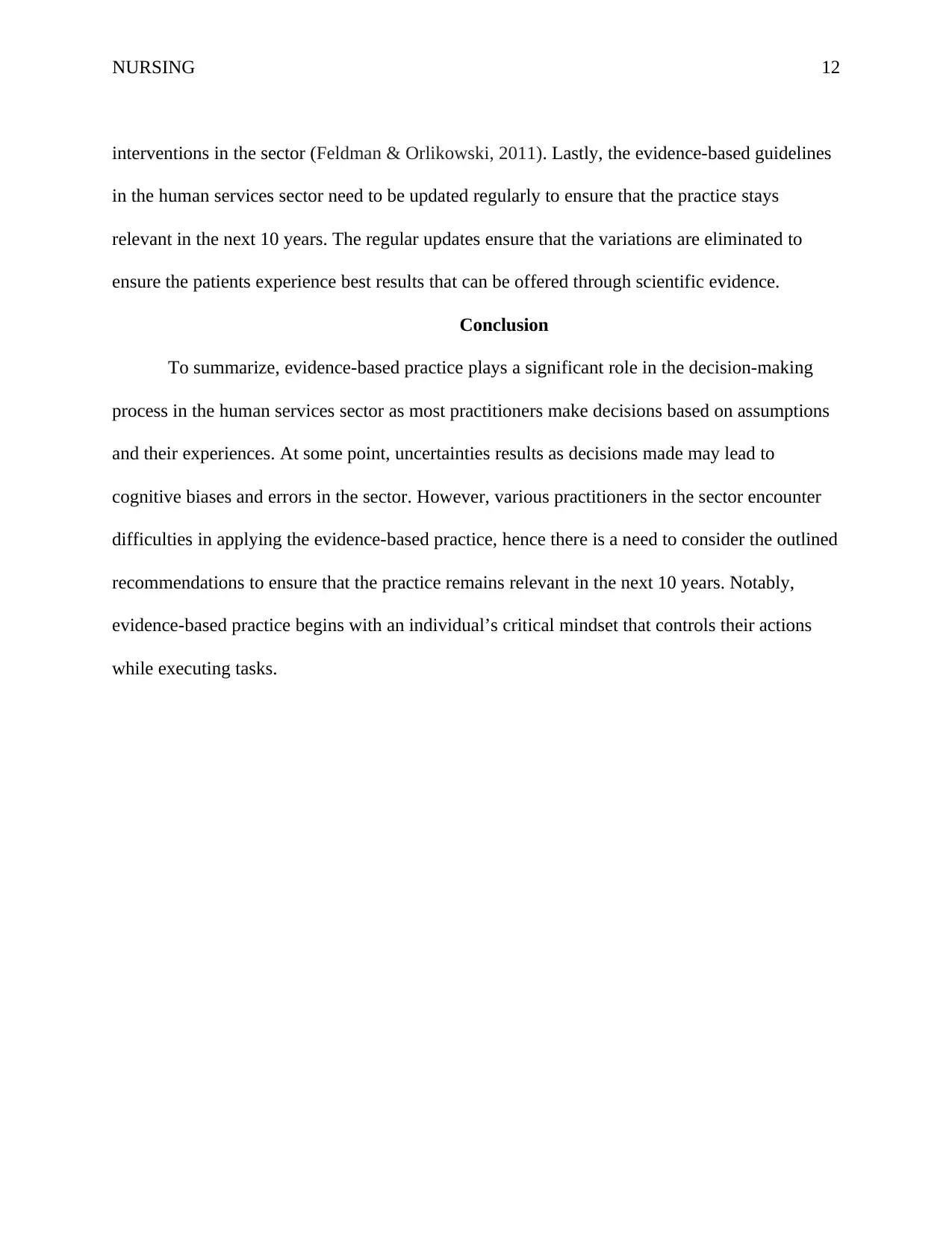
NURSING 12
interventions in the sector (Feldman & Orlikowski, 2011). Lastly, the evidence-based guidelines
in the human services sector need to be updated regularly to ensure that the practice stays
relevant in the next 10 years. The regular updates ensure that the variations are eliminated to
ensure the patients experience best results that can be offered through scientific evidence.
Conclusion
To summarize, evidence-based practice plays a significant role in the decision-making
process in the human services sector as most practitioners make decisions based on assumptions
and their experiences. At some point, uncertainties results as decisions made may lead to
cognitive biases and errors in the sector. However, various practitioners in the sector encounter
difficulties in applying the evidence-based practice, hence there is a need to consider the outlined
recommendations to ensure that the practice remains relevant in the next 10 years. Notably,
evidence-based practice begins with an individual’s critical mindset that controls their actions
while executing tasks.
interventions in the sector (Feldman & Orlikowski, 2011). Lastly, the evidence-based guidelines
in the human services sector need to be updated regularly to ensure that the practice stays
relevant in the next 10 years. The regular updates ensure that the variations are eliminated to
ensure the patients experience best results that can be offered through scientific evidence.
Conclusion
To summarize, evidence-based practice plays a significant role in the decision-making
process in the human services sector as most practitioners make decisions based on assumptions
and their experiences. At some point, uncertainties results as decisions made may lead to
cognitive biases and errors in the sector. However, various practitioners in the sector encounter
difficulties in applying the evidence-based practice, hence there is a need to consider the outlined
recommendations to ensure that the practice remains relevant in the next 10 years. Notably,
evidence-based practice begins with an individual’s critical mindset that controls their actions
while executing tasks.
⊘ This is a preview!⊘
Do you want full access?
Subscribe today to unlock all pages.

Trusted by 1+ million students worldwide
1 out of 15
Related Documents
Your All-in-One AI-Powered Toolkit for Academic Success.
+13062052269
info@desklib.com
Available 24*7 on WhatsApp / Email
![[object Object]](/_next/static/media/star-bottom.7253800d.svg)
Unlock your academic potential
Copyright © 2020–2025 A2Z Services. All Rights Reserved. Developed and managed by ZUCOL.





